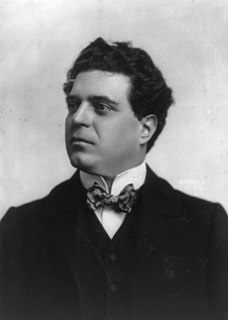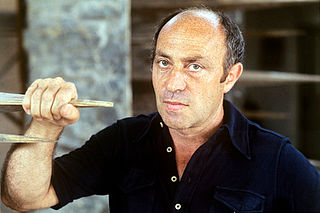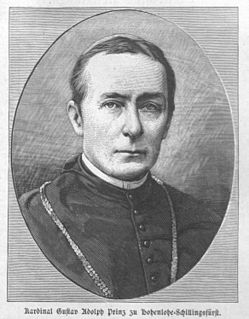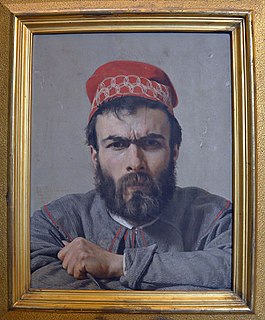Gioacchino Pagliei [1] (born 1852 in Subiaco, Lazio, died 1896 in Rome) was an Italian painter who worked in the Neo-Pompeian genre.
Contents

Gioacchino Pagliei [1] (born 1852 in Subiaco, Lazio, died 1896 in Rome) was an Italian painter who worked in the Neo-Pompeian genre.

Pagliei studied in Rome at the Accademia di San Luca, where in 1871 he won an award for a drawing and essay. In 1875, he won the Stanziani competition. [2]
A follower of F. Grandi, he worked on the decoration of the church of San Lorenzo in Damaso. He also worked at the Palazzo del Quirinale and the Villino Gamberini. [2]
His oil painting style followed the Neo-Pompeian genre.
He was introduced to the Società degli Amatori e Cultori delle Belle Arti in the 1880s where he exhibited A Costume of the Empire, 1882; The Embarrassment, 1884; and Nella scala, 1895–1896. [2]
Pagliei's works include:

Pietro Mascagni was an Italian composer primarily known for his operas. His 1890 masterpiece Cavalleria rusticana caused one of the greatest sensations in opera history and single-handedly ushered in the Verismo movement in Italian dramatic music. While it was often held that Mascagni, like Ruggero Leoncavallo, was a "one-opera man" who could never repeat his first success, L'amico Fritz and Iris have remained in the repertoire in Europe since their premieres.

William-Adolphe Bouguereau was a French academic painter. In his realistic genre paintings he used mythological themes, making modern interpretations of classical subjects, with an emphasis on the female human body. During his life, he enjoyed significant popularity in France and the United States, was given numerous official honors, and received top prices for his work. As the quintessential salon painter of his generation, he was reviled by the Impressionist avant-garde. By the early twentieth century, Bouguereau and his art fell out of favor with the public, due in part to changing tastes. In the 1980s, a revival of interest in figure painting led to a rediscovery of Bouguereau and his work. He finished 822 known paintings, but the whereabouts of many are still unknown.

Arnaldo Pomodoro is an Italian sculptor. He was born in Morciano, Romagna, and lives and works in Milan. His brother, Giò Pomodoro (1930–2002) was also a sculptor.

Raimundo de Madrazo y Garreta was a Spanish painter from the Madrazo family of artists who worked in the Realistic style, although his later work shows signs of Rococo and Japanese influence. He was known primarily for his genre paintings and portraits. His grandfather was José de Madrazo, his father was the portrait painter Federico de Madrazo and his brother was Ricardo de Madrazo.

Gustav Adolf, Cardinal Prince of Hohenlohe-Schillingfürst, was a member of the Hohenlohe family of Germany, claiming descent from Eberhard, one of the early dukes of Franconia. He became a cardinal of the Catholic Church.

Francesco Satolli was an Italian theologian, professor, cardinal, and the first Apostolic Delegate to the United States.

Domenico Morelli was an Italian painter, who mainly produced historical and religious works. Morelli was immensely influential in the arts of the second half of the 19th century, both as director of the Accademia di Belle Arti in Naples, but also because of his rebelliousness against institutions: traits that flourished into the passionate, often patriotic, Romantic and later Symbolist subjects of his canvases. Morelli was the teacher of Vincenzo Petrocelli.

Adolfo Hohenstein was a German painter, advertiser, illustrator, set designer and costume designer. Hohenstein is considered the father of Italian poster art and an exponent of the Stile Liberty, the Italian Art Nouveau. Together with Leonetto Cappiello, Giovanni Mario Mataloni, Leopoldo Metlicovitz and Marcello Dudovich, he is considered one of the most important Italian poster designers.
Mario Spinetti (1848–1925) was an Italian painter, whose works depict mythologic, Neo-Pompeian, and sacred subjects. He was born and resident in Rome. Among his works: a half-figure, Lidia, in 1881 in Milan. At the 1883 Exposition of Fine Arts in Rome, he exhibited a painting titled: Virginibus puerisque canto. In 1884 in Turin, he exhibited: Marriage in the 16th century. In 1887, in Venice, he exhibited: Una poetesa. In 1899, he painted frescoes of Sain Zaccaria, John the Baptist, and Elisabeth and Faith and Charity in the apse of the church of San Giovanni Battista dei Genovesi in Rome.
Catello Palmigiano was an Italian painter, mainly of genre subjects, often in period costume.
Gaetano Mormile was an Italian painter, mainly of genre subjects, often peasants in folkloric dress, but also vedute and Neo-Pompeian subjects.

Raffaello Sorbi was a 19th-20th century Florentine painter, specializing in narrative painting.
Anatolio Scifoni was an Italian painter of mainly genre paintings.

Napoleone Verga was an Italian painter, mainly of illuminated manuscripts, but also of paintings.

Luigi Serra was an Italian painter, known for his watercolors.

Camillo Miola, also known as Biacca, was an Italian painter, often painting exotic Neo-Pompeian and Orientalist subjects. He also painted history and portraits.
Raffaele Quattrucci was an Italian painter, depicting genre subjects and portraits. He also began to paint in the 1880s Neo-Pompeian and Orientalist subjects.
Giuseppe De Nigris was an Italian painter, who depicted genre, Neo-Pompeian, and still-life subjects.

Luigi Bazzani, also called Il Bazzanetto, was an Italian painter, illustrator, and watercolorist. He was born November 8, 1836 in Bologna, Italy. Bazzani studied at Bologna's Accademia di Belle Arti then traveled to France, Germany and, eventually, Rome where he settled down in 1861 and began to specialize in genre and landscape subjects as well as set designs for theaters. Many of his paintings featured the remains of the city's monuments from classical antiquity.

Pierre Olivier Joseph Coomans was a noted painter and illustrator born in Brussels, Belgium on June 28, 1816. He was the son of Josse-Joseph Coomans (1787-1868), inspector of registration and estates and author of novels and poetry, and Cécile Lesprit (1792-1871). He was known as one of Belgium's most celebrated 19th-century painters of historic subjects, genre scenes, and landscapes.